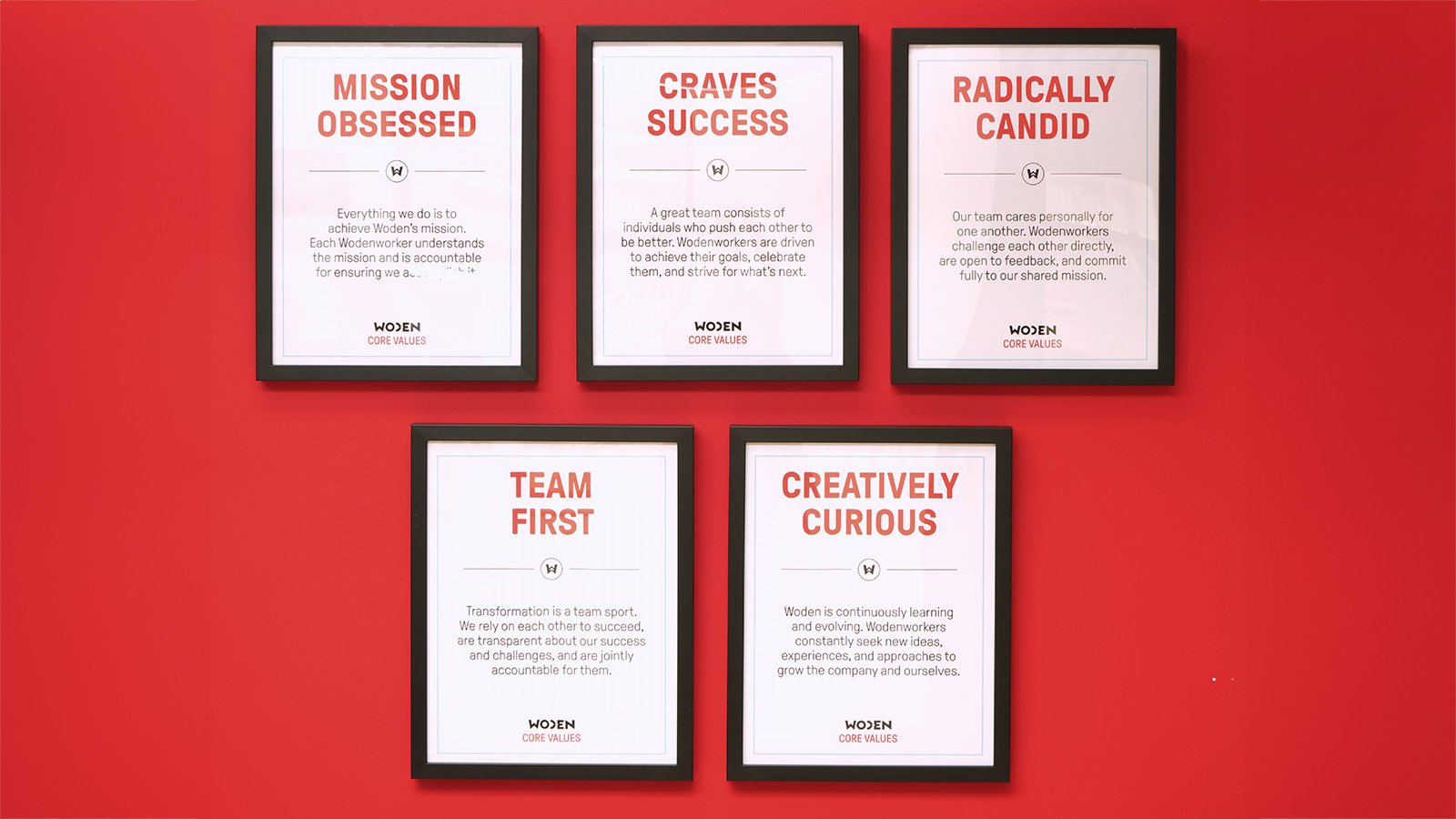Woden’s Messaging Hierarchy translates your StoryKernel into simple, memorable storytelling tools
Your story is only as powerful as how it’s told. The StoryKernel captures your purpose and inspires your team. But to become essential, a brand must align every interaction it has with the market behind its narrative.
Woden’s Messaging Hierarchy brings your strategic narrative to life.
Your brand’s story is your strategy. But that strategy is only actionable when you persuade people to challenge the status quo. Buyers must remember what makes you unique across long, competitive sales cycles. And your team needs simple ways to remember that value as they advance your mission each day.
The Messaging Hierarchy aligns your internal storytelling, critical elements of your messaging and your positioning to pull buyers towards your brand. Each element is derived from the StoryKernel: consistent, compelling storytelling that ensures your brand memorable.
Begin with Belief
The Messaging Hierarchy is anchored by your brand’s Purpose. This is the belief that drives your organization forward—it’s why your brand started in the first place.
Your purpose is constant. It anchors your brand even as markets shift or customer expectations evolve.
The StoryKernel defines the strategy required to achieve this purpose. Woden’s nine-part arc focuses the brand on how to connect its belief with its buyer, and in turn, how the customer realizes their own potential.
Each StoryKernel has a five-to-ten-year horizon. It can be revisited when strategy evolves—like entering a new market—and a refreshed story is needed.
The Messaging Hierarchy then translates each part of the StoryKernel into a memorable piece of language. These elements of the Messaging Hierarchy evolve more regularly: on a two- to five-year cycle. They are designed to adapt to the market and the needs of customers.
Finally, the language defined by the Messaging Hierarchy comes to life in your customer journey. The stories your audience interacts with daily should evolve just as quickly: the multi-year stability of the Messaging Hierarchy provides a starting point for everything from email campaigns to internal communications.
Woden’s Messaging Hierarchy means a brand never needs to go back to square one, which keeps it agile and ahead of the market.
When any part of the hierarchy evolves, the brand has elements above it to provide a constant around which to pivot. Changes to the StoryKernel should be infrequent and optimized for long-term impact. But other elements are purposefully flexible, so your brand can be dynamic in response to internal or external factors.
Strategic Narrative: The StoryKernel
Your StoryKernel distills your brand down its most essential elements in just a few hundred words. But to reach its transformative potential, the StoryKernel must be translated into every story your team tells so that each interaction with your audience reinforces your belief.
The Messaging Hierarchy provides language that makes it easy for your team and your customers to understand and share the StoryKernel.
Each element of the hierarchy is derived from one of the StoryKernel’s nine parts:
- Existential Threat → Verbal Identity
- Shared Threat → Verbal Identity
- Our Hero and Their Meaning → Buyer Personas
- The Mentor and Their Allies → Values
- Call to Adventure → Mission
- The Talisman → Positioning
- Obstacles to Overcome → Differentiators
- Spoils of Victory → Brand Promise
- Potential Achieved → Vision
The Messaging Hierarchy intentionally aligns with concepts familiar to your audience: this makes them both more memorable and audiences more likely to adopt them as they follow existing paradigms.
Make Your Story Memorable
The most important audience for your Messaging Hierarchy is internal. Bringing your StoryKernel into the market requires your team to fully understand and be aligned with your strategy.
The Messaging Hierarchy makes it easy to keep the StoryKernel’s arc in front of the team and for them to incorporate it in daily interactions with customers and with each other.
Verbal Identity defines the one to five specific terms and phrases your brand should own in customers’ minds. This mindshare is critical at the top of the funnel: buyers are more likely to remember these terms than the brand name. They are derived from the Existential and Shared Threats in the StoryKernel.
Research shows consumers instinctively associate specific terms with particular brands. The connection is singular (any given term has only one brand association for the buyer) so it’s critical to define language unique to your brand. The Verbal Identity should be used consistently and repeatedly across all storytelling applications.
Woden’s Verbal Identity: StoryKernel, strategic narrative, essential brands, Story is the Strategy
Buyer Personas provide depth to the varied stakeholders who influence buying decisions for your brand. The StoryKernel has a singular Hero, but large B2B buying committees have different people the story must resonate with. And in B2C the psychographic profile of the Hero may become several different buyers.
Buyer Personas bring nuance to your story by tailoring the StoryKernel to each’s unique motivations, pain points, and decision criteria. Because each persona is derived from the StoryKernel, the messaging to each is aligned—critical in B2B.
Values are the three to seven behaviors and attitudes your team exhibits in interactions with each other and with your customers. Values emerge from the Mentor section of StoryKernel and form the basis of the bond between brand and buyer.
Research has shown that people are more likely to do business with those who share their values. Values should be unique to your brand; the way your team lives them defines your culture and serves your customer.
Woden’s Values: Mission-Obsessed, Craves Success, Team-First, Radically Candid, Creatively Curious
Mission is an action-oriented statement that defines how your team puts your purpose into practice each day. The Mission is derived from the Call to Adventure in your StoryKernel.
Your Mission provides your team guidance on what your brand is seeking to achieve. Everything your team does must be in service of achieving the Mission.
Woden’s Mission: Transform Purposeful Companies into Essential Brands
Positioning states why your brand is the best solution to address the obstacles your hero must overcome in the story. It is derived from the StoryKernel’s Talisman, and should be a concise statement that sets your brand apart.
Positioning should capture both the tangible aspects of your product or service and the value it delivers. This ensures your buyer understands how you deliver your solution and why you are different.
Woden’s Positioning: Strategic narrative for essential brands.
Differentiators capture what sets you apart from all other solutions available to the buyer. They are derived from the Obstacles to Overcome in the StoryKernel; brands should aim for no more than three.
Your differentiators clarify what your brand is best at. By connecting them to the specific challenges buyers must overcome in the story, it makes their impact tangible and customer-centric. Differentiators should answer the buyer’s question: “Why you?”
Woden’s Differentiators: Defined Messaging Hierarchy, Story-aligned customer journey,Team-based engagements, vertical and industry agnostic,
Brand Promise is the commitment your company makes to your customer. It’s a statement that captures the ROI they can expect from partnering with you, and comes from the Spoils of Victory in the StoryKernel.
Brand Promises give buyers confidence. They should be specific, authentic, and are often backed by a guarantee to reinforce how seriously the brand takes its commitment.
Woden’s Promise: Your customers and prospects will see you as essential. And, backed by our guarantee.
Vision defines the impact your brand aims to make in the world. The statement should describe an end state drawn from the Potential Achieved section of the StoryKernel. The Vision extends beyond your brand to the entire market to capture the “dent you aim to make in the universe.”
An effective Vision rallies your team and customers. It helps them see what’s possible beyond your current offerings and invites them to join you on your own journey.
Woden’s Vision: To establish a strategic brand story as the foundation of successful organizations.
The Framework for Transformation
Your market and your buyers are changing more rapidly than ever. The StoryKernel provides you the stability you need to navigate this change, and the Messaging Hierarchy keeps all of your stakeholders aligned with this strategy—and advancing your brand towards its potential.
Woden uses the StorySeminar to achieve this transformation in your brand.
StorySeminar brings the Messaging Hierarchy to the storytellers within your organization. Just as the StoryKernel is revealed through interviews with your team and interactions with your customers, the Messaging Hierarchy must be collaboratively developed to get your team fully aligned.
When a team works together to translate the StoryKernel into a Messaging Hierarchy, it creates an entire narrative strategy. This ensures every interaction, from sales conversations to product innovation, supports your strategy. The StorySeminar prepares you to achieve deeper customer connections, greater agility, and enduring competitive advantages.
The Messaging Hierarchy empowers your team to tell your story across its entire go-to-market. This consistent messaging creates a “pull” motion across the customer journey that efficiently attracts best-fit customers and guarantees each of them sees your brand as essential.

